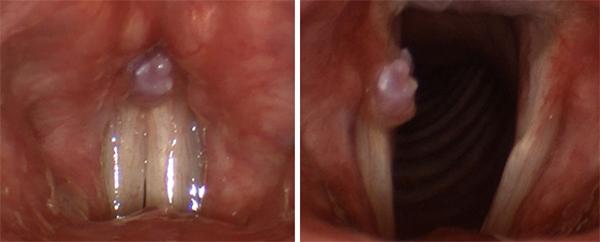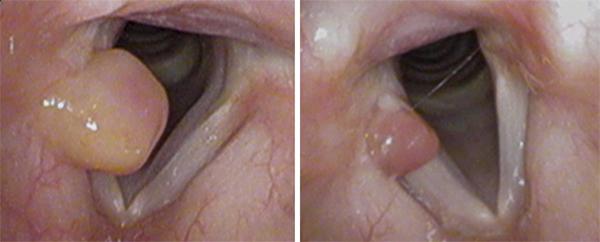What is a granuloma?
A granuloma is a benign growth resulting from irritation or trauma. It is usually found at the back of the vocal fold, over a part of cartilage called the vocal process, which lies just underneath the membrane covering the larynx. Because there is little overlying soft tissue for cushioning, it is prone to trauma from impact with the vocal process of the opposite vocal fold, when the folds come together. This happens during regular speaking, and even more forcefully during loud speaking, singing, throat clearing, and coughing.

Here a granuloma grows over the vocal process of the vocal fold. Somewhat hidden during voicing (left), it is obvious when the vocal folds open (right). The location shows how the area is traumatized when the vocal folds come into contact.
The area around the vocal process may also become irritated from a breathing tube, routinely placed through the vocal folds during general anesthesia. This creates a special type of granuloma known as an intubation granuloma, which tends to grow in the days and weeks after the general anesthetic. Because these are not related to voice behavior, they are generally less stubborn than granulomas that arise spontaneously.
There is very good evidence that laryngopharyngeal reflux, an important source of irritation in the larynx, contributes significantly to the formation of a granuloma.
What are the symptoms of a granuloma?
Commonly, the symptoms of granuloma include pain, perception of a foreign body in the throat, hoarseness and voice breaks. The first of these symptoms can be especially troublesome, as it is likely to provoke throat clearing or coughing, which can worsen the granuloma. This gives rise to a cycle of irritation and granuloma formation which can be hard to break.
The location of a granuloma is so characteristic, that this alone is nearly enough to make a diagnosis. Unlike many benign vocal fold growths, a granuloma is not generally found at the midpoint of the vibratory part of the vocal fold. Conversely, nearly all growths found over the vocal process at the back of the vocal fold are granulomas. Polyps do not form here.
Voice symptoms generally result from the mass of a granuloma, which can prevent even closure of the vocal folds necessary for normal voice production. In such a situation, hoarseness is typically breathy, and it is difficult to raise the volume of the voice. Again, a cycle may begin in which a person tries harder and harder to speak loudly, thereby increasing vocal fold trauma and worsening the granuloma. If the granuloma is attached to the vocal fold by a stalk (see figures below), it can flip in and out of the way of the vocal folds and cause intermittent voice breaks, rather than outright hoarseness.

Granulomas are often amenable to medical, as opposed to surgical, management. This bulky left-sided granuloma (left) reduced in size considerably after four weeks of treatment with medication alone (right).
A granuloma is one of the few vocal fold growths that can cause pain, often sharp and localized during coughing, swallowing or throat clearing when the granuloma is directly irritated. Occasionally, pain can be felt in the ear from the side of the granuloma mass. This phenomenon is known as “referred pain", and results from the pattern of sensory nerves in the head and neck.
What does a granuloma look like?
A granuloma is usually a reddish or pale lesion that occurs at its characteristic location over the vocal process, and may resemble a mound of tissue raised from the surrounding mucosa. A granuloma may grow to be quite large, forming a smooth spherical mass as in the figure above, and can be either broad-based or narrow-necked. Sometimes, there is a cleft in the mass created by repeated impact of the edge of the opposite vocal fold. Granulomas tend to grow until the causes of irritation are addressed. Occasionally a granuloma will become so large that it will outgrow its blood supply and slough off.
How is a granuloma treated?
Aggressive steps to control reflux, including anti-acid medication and changes in diet, are always helpful. Often medication must be taken in high doses, in excess of those recommended for routine control of reflux, for up to several months. There is no evidence that antibiotics are helpful in most cases.
Voice therapy aimed at correcting behaviors that cause vocal fold trauma, such as habitual loud talking or throat clearing, is as important. People generally underestimate the effect and importance of such behaviors, and stubborn cases of granuloma may result from poor control of these factors.
Surgery is generally a treatment of last resort, as most granulomas will shrink and eventually disappear with proper medical measures and behavioral changes. Surgical removal can be used in cases where a very large granuloma is likely to take a long time to resolve, in order to reduce symptoms while treatment takes effect. Again, surgery without treatment results in recurrence of the granuloma in the majority of cases.
Too often, surgical removal is used as a “quick fix” for granulomas because it is considered to be easier than treating reflux and changing harmful vocal behaviors, both of which require discipline and patience. Surgery is a poor substitute, however, as most granulomas grow back. Determined patients who practice non-surgical treatment, on the other hand, can avoid the need for surgery altogether.

